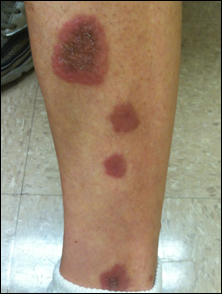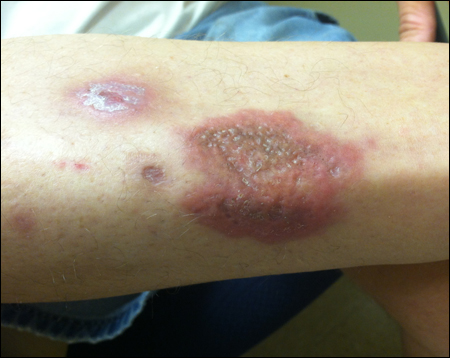The 'skinny' on diabetes
Necrobiosis Lipoidica (diabeticorum), mainly described and discussed in the dermatology literature1, is strongly linked to diabetes. As far as I can gather from extensive literature searching, the etiology is uncertain, but the most common suggested etiology is microvascular necrosis of subcutaneous blood vessels.
The photos shown below are of a patient seen in clinic recently. While I went searching for a colleague in dermatology, my very astute resident had the foresight to pull out her iPhone and capture the lesions on film. Thank you.


Figure 1. Scleredema diabeticorum on a patient seen during a recent clinic visit.
Source: Michael Kleerekoper, MD, MACE
The dermatologist immediately recognized the condition, and biopsy has been scheduled to rule out any likelihood of malignancy and gain insight into the histopathology. Ahlam A. Alsomali, MD, PGY2 Internal Medicine, University of Toledo, will generate a poster on this patient so I won’t add any specific comments in this blog. Any and all of you please feel free to add to my knowledge base.
“Peau d’orange” is an affectionate term for scleredema diabeticorum because the skin lesion does indeed look like orange peel, as seen in the photo that I took of a patient a few years ago. The prevalence in diabetes is reported as 5% to 15% for patients with long-term diabetes. That can only mean that I have missed this in many patients. A few therapeutic options have been reported2 . This dermopathy is common in other conditions3.
Eruptive xanthomas, as seen in the photo below and about which I’ve blogged before, is also seen in diabetes, but it is most often the result of marked hypertriglyceridemia (>7,000 mg/dL in this patient). Surprisingly, when I saw him in follow-up recently, he had just one tiny xanthomas left, yet his triglycerides remained high at approximately 3,500 mg/dL.
And of course acanthosis nigricans is not uncommon in diabetes.

Source: Michael Kleerekoper, MD, MACE
For more information:
1: O'Reilly K. Necrobiosis lipoidica. Dermatol Online J. 2011;17:18.
2:Thumpimukvatana N. Scleredema diabeticorum successfully treated with ultraviolet A1 phototherapy. J Dermatol. 2010;37:1036-1039.
3: Nashel J. Scleroderma mimics. Curr Rheumatol Rep. 2012;14:39-46.
